Company history
Significant milestones in the 20 year history of Cultural Care Au Pair and the au pair program in the United States.
Due to the increasing demand for quality childcare in the American family, in 1986, the USIA (United States Information Agency) grants a select number of U.S. cultural exchange organizations permission to arrange programs that promote international understanding through cultural exchange by accommodating the need for flexible, live-in childcare in the United States. The organizations are authorized to run au pair programs that followed strict guidelines set by the USIA.
1988
 The au pair program is a natural extension for EF Education, the world leader in international education and a company committed to promoting cultural exchange and creating an international dialogue. EF Education launches a new division of its international program offerings – a company that provides childcare and cultural enrichment for all involved. EF Au Pair (later to become Cultural Care Au Pair) is designated as an au pair sponsor organization by the United States Information Agency.
The au pair program is a natural extension for EF Education, the world leader in international education and a company committed to promoting cultural exchange and creating an international dialogue. EF Education launches a new division of its international program offerings – a company that provides childcare and cultural enrichment for all involved. EF Au Pair (later to become Cultural Care Au Pair) is designated as an au pair sponsor organization by the United States Information Agency.
1989
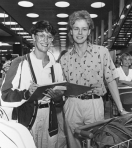 EF Au Pair starts recruiting young women and men in Germany, the Netherlands and Sweden, where EF has strong roots. The first EF au pair is placed, a male au pair, Karl Magnus Johansson, and our first group of au pairs, all Swedish, depart for the U.S. to live with families in Boston, Chicago and Los Angeles.
EF Au Pair starts recruiting young women and men in Germany, the Netherlands and Sweden, where EF has strong roots. The first EF au pair is placed, a male au pair, Karl Magnus Johansson, and our first group of au pairs, all Swedish, depart for the U.S. to live with families in Boston, Chicago and Los Angeles.
1990
 Congress approves of and extends the au pair program’s two-year authorization period under the United States Information Agency and instructs USIA to continue the program under the then-existing guidelines.
Congress approves of and extends the au pair program’s two-year authorization period under the United States Information Agency and instructs USIA to continue the program under the then-existing guidelines.
1991
 We host our first worldwide training conference in Berlin for all EF Au Pair staff. The meeting allows the au pair recruitment teams and U.S. program staff to collaborate on quality standards, confer on regulation compliance, set appropriate expectations and achieve exceptional communication within the organization.
We host our first worldwide training conference in Berlin for all EF Au Pair staff. The meeting allows the au pair recruitment teams and U.S. program staff to collaborate on quality standards, confer on regulation compliance, set appropriate expectations and achieve exceptional communication within the organization.
1992
 A group of U.S. international exchange organizations, including EF Au Pair, forms the Alliance for International Educational and Cultural Exchange to sustain and improve the climate for international exchange policy and the powerful people-to-people connections they foster. The Alliance is established to promote federal policies that support and advance international exchange in all its dimensions. EF Au Pair staff maintains positions on the board and executive committee.
A group of U.S. international exchange organizations, including EF Au Pair, forms the Alliance for International Educational and Cultural Exchange to sustain and improve the climate for international exchange policy and the powerful people-to-people connections they foster. The Alliance is established to promote federal policies that support and advance international exchange in all its dimensions. EF Au Pair staff maintains positions on the board and executive committee.
1993
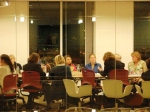 Our first national meeting is held for Local Childcare Coordinators and an annual tradition is established. Once a year, Cultural Care LCCs from all over the U.S. gather for a training and networking weekend. The national meetings are designed to encourage the sharing of best practices as well as program developments and customer service enhancements.
Our first national meeting is held for Local Childcare Coordinators and an annual tradition is established. Once a year, Cultural Care LCCs from all over the U.S. gather for a training and networking weekend. The national meetings are designed to encourage the sharing of best practices as well as program developments and customer service enhancements.
1994
 As a leader in the field, EF Au Pair is a founding member of the International Au Pair Association (IAPA) an organization dedicated to protecting the rights of au pairs and host families by establishing internationally approved guidelines for au pair exchange programs. IAPA recognizes the continued growth in the au pair program and works to develop and implement professional standards for au pair organizations. Cultural Care staff is elected to and serves on the Executive Board of IAPA for many years.
As a leader in the field, EF Au Pair is a founding member of the International Au Pair Association (IAPA) an organization dedicated to protecting the rights of au pairs and host families by establishing internationally approved guidelines for au pair exchange programs. IAPA recognizes the continued growth in the au pair program and works to develop and implement professional standards for au pair organizations. Cultural Care staff is elected to and serves on the Executive Board of IAPA for many years.
1995
 Congress authorizes the USIA to create specific regulations to govern the au pair program. Existing guidelines are replaced with comprehensive regulations, published in the Federal Register, addressing au pair and host families selection, screening, and placement. These new regulations call for extensive au pair training and EF Au Pair works closely with The Children’s Foundation to establish a comprehensive curriculum in child safety and development for our Au Pair Training School.
Congress authorizes the USIA to create specific regulations to govern the au pair program. Existing guidelines are replaced with comprehensive regulations, published in the Federal Register, addressing au pair and host families selection, screening, and placement. These new regulations call for extensive au pair training and EF Au Pair works closely with The Children’s Foundation to establish a comprehensive curriculum in child safety and development for our Au Pair Training School.
1996
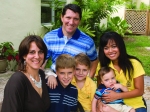 New legislation creates a permanent au pair program under the supervision of the United States Information Agency and removes limitations on the number of visas available to au pairs as well as restrictions on locations from which au pairs can be recruited. This allows EF Au Pair to open new markets for both host families and au pairs and we look to introduce the au pair program in new states, countries and continents.
New legislation creates a permanent au pair program under the supervision of the United States Information Agency and removes limitations on the number of visas available to au pairs as well as restrictions on locations from which au pairs can be recruited. This allows EF Au Pair to open new markets for both host families and au pairs and we look to introduce the au pair program in new states, countries and continents.
1997
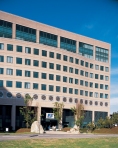 EF Au Pair staff continues to work closely with government officials providing feedback in discussions forums and through industry meetings. In consideration of these contributions, additional regulations are published in the Federal Register providing further clarification regarding au pair screening and training and limiting the number of hours per day an au pair may provide child care. EF Au Pair moves to EF Cener, One Education Street, Cambridge, MA.
EF Au Pair staff continues to work closely with government officials providing feedback in discussions forums and through industry meetings. In consideration of these contributions, additional regulations are published in the Federal Register providing further clarification regarding au pair screening and training and limiting the number of hours per day an au pair may provide child care. EF Au Pair moves to EF Cener, One Education Street, Cambridge, MA.
1998
 Developed in partnership with the National Safe Kids Campaign, our Continuing Education Program (CEP) ensures that au pairs receive ongoing training through safety programs scheduled periodically throughout the year. Informal seminars supply au pairs with the most current information available on safety measures and injury prevention for children. Local childcare coordinators host CEP safety seminars and invite local authorities and safety educators to facilitate the training.
Developed in partnership with the National Safe Kids Campaign, our Continuing Education Program (CEP) ensures that au pairs receive ongoing training through safety programs scheduled periodically throughout the year. Informal seminars supply au pairs with the most current information available on safety measures and injury prevention for children. Local childcare coordinators host CEP safety seminars and invite local authorities and safety educators to facilitate the training.
1999
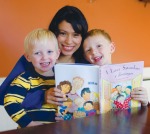 EF Au Pair opens its first office in Sao Paulo, Brazil, marking significant expansion outside Europe. Development of the program in South America expands quickly due to the interest in the au pair experience among young women and men in this region and the desire for Spanish speaking au pairs among host families.
EF Au Pair opens its first office in Sao Paulo, Brazil, marking significant expansion outside Europe. Development of the program in South America expands quickly due to the interest in the au pair experience among young women and men in this region and the desire for Spanish speaking au pairs among host families.
2000
 U.S. Senator Edward M. Kennedy dedicates a piece of the Berlin Wall outside the EF office in a ceremony coordinated by EF Au Pair staff. “It is fitting that EF Education is hosting this ceremony today, and is bringing this portion of the Wall to Massachusetts,” saysKennedy. “Like the people of Eastern Europe who brought down the Wall, each of you has admirably worked to break down the barriers of language, culture and geography that divide the peoples of the world.” The historic piece goes on permanent display at our office and is New England’s only publicly accessible section of the Berlin Wall.
U.S. Senator Edward M. Kennedy dedicates a piece of the Berlin Wall outside the EF office in a ceremony coordinated by EF Au Pair staff. “It is fitting that EF Education is hosting this ceremony today, and is bringing this portion of the Wall to Massachusetts,” saysKennedy. “Like the people of Eastern Europe who brought down the Wall, each of you has admirably worked to break down the barriers of language, culture and geography that divide the peoples of the world.” The historic piece goes on permanent display at our office and is New England’s only publicly accessible section of the Berlin Wall.
2001
 In the immediate aftermath of the attacks at the World Trade Center, EF au pairs en route to the Au Pair Training School in New York are re-routed to Gander, Canada and are cared for by hospitable citizens of this small town for four days. As the country contemplates the ramifications of 9/11, EF Au Pair witnesses an increased demand for au pairs as families continue to embrace the cultural exchange aspect of the program and welcome young people from another culture into their home.
In the immediate aftermath of the attacks at the World Trade Center, EF au pairs en route to the Au Pair Training School in New York are re-routed to Gander, Canada and are cared for by hospitable citizens of this small town for four days. As the country contemplates the ramifications of 9/11, EF Au Pair witnesses an increased demand for au pairs as families continue to embrace the cultural exchange aspect of the program and welcome young people from another culture into their home.
2002
![]() EF Au Pair becomes Cultural Care Au Pair as we choose a new name that more accurately reflects our current mission and future vision. This phrase is selected to represent our goal of exposing a variety of individuals, of all ages and walks of life, to the rewarding benefits of cultural exchange.
EF Au Pair becomes Cultural Care Au Pair as we choose a new name that more accurately reflects our current mission and future vision. This phrase is selected to represent our goal of exposing a variety of individuals, of all ages and walks of life, to the rewarding benefits of cultural exchange.
2003
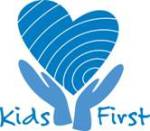 Our Kids First program is introduced to make a difference in the lives of children in need in the U.S. and overseas. Our first campaign focuses on a Russian orphanage that is home to children with little hope for adoption. Through the sale of an international cookbook and a CD of children’s songs we are able to purchase the biggest item on their wish list, a bus. Other partners include a daycare center that cares for some of the neediest children in South Africa, an after-school center in Brazil that offers arts and culture programs to at-risk children and a school located in the heart of New Orleans that opened its doors after Hurricane Katrina to children of all ages and means. 100% of all donations and funds raised go directly to children in need and are matched by Cultural Care.
Our Kids First program is introduced to make a difference in the lives of children in need in the U.S. and overseas. Our first campaign focuses on a Russian orphanage that is home to children with little hope for adoption. Through the sale of an international cookbook and a CD of children’s songs we are able to purchase the biggest item on their wish list, a bus. Other partners include a daycare center that cares for some of the neediest children in South Africa, an after-school center in Brazil that offers arts and culture programs to at-risk children and a school located in the heart of New Orleans that opened its doors after Hurricane Katrina to children of all ages and means. 100% of all donations and funds raised go directly to children in need and are matched by Cultural Care.
2004
 The Bureau of Educational and Cultural Affairs within the U.S. Department of State (formerly USIA) introduces a pilot program allowing au pairs to extend their stay in the United States for 6, 9 or 12 months. Cultural Care au pairs and host families embrace the opportunity the extension program provides and more than 30% of au pairs extend their au pair year.
The Bureau of Educational and Cultural Affairs within the U.S. Department of State (formerly USIA) introduces a pilot program allowing au pairs to extend their stay in the United States for 6, 9 or 12 months. Cultural Care au pairs and host families embrace the opportunity the extension program provides and more than 30% of au pairs extend their au pair year.
2005
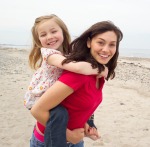 Cultural Care strives to provide the latest in customer service tools through advances and investments in technology and introduces an on-line application for host families. The on-line application not only allows busy families to save-as-they-go and use the same, easily updated, application from year to year, it also expedites the interviewing and matching process, allowing families to start reviewing au pair applications more quickly.
Cultural Care strives to provide the latest in customer service tools through advances and investments in technology and introduces an on-line application for host families. The on-line application not only allows busy families to save-as-they-go and use the same, easily updated, application from year to year, it also expedites the interviewing and matching process, allowing families to start reviewing au pair applications more quickly.
2006
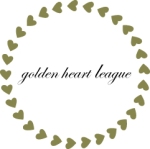 The Golden Heart League is established to recognize those local childcare coordinators who go above and beyond – those who provide exceptional service to their host families and au pairs, who place great importance on compliance with program regulations and who strive for growth in their communities. These LCCs maintain the highest level of service and are the “gold standard” for our local coordinators.
The Golden Heart League is established to recognize those local childcare coordinators who go above and beyond – those who provide exceptional service to their host families and au pairs, who place great importance on compliance with program regulations and who strive for growth in their communities. These LCCs maintain the highest level of service and are the “gold standard” for our local coordinators.
2007
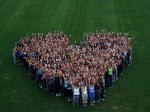 InfoSource, an extensive on-line resource for local coordinators, host families and au pairs, is introduced. InfoSource contains hundreds of pages of information on all aspects of the program with search and commenting functions that make it both interactive and easy to navigate . The user-generated content and advice from veteran host families provide invaluable guidance for both interested and current host families. Au pairs, now arriving up to 300 at a time at the Au Pair Training School, embrace our techonology to prepare themselves for their year in the United States.
InfoSource, an extensive on-line resource for local coordinators, host families and au pairs, is introduced. InfoSource contains hundreds of pages of information on all aspects of the program with search and commenting functions that make it both interactive and easy to navigate . The user-generated content and advice from veteran host families provide invaluable guidance for both interested and current host families. Au pairs, now arriving up to 300 at a time at the Au Pair Training School, embrace our techonology to prepare themselves for their year in the United States.
2008
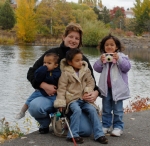
Over the years, feedback provided by our program participants allows us to become a leader in the au pair program community. Cultural Care develops an innovative new method to capture feedback and an extensive customer satisfaction survey is developed in partnership with Discovery Surveys, Inc. Our families embrace this new way to share their opinions and their comments, positive or negative, to continue to help us enhance the experience of our participants. The results are incredibly insightful and allow us to develop ways to respond to the growing and changing needs of the Cultural Care host family. One host family, the Sato family in California, provides feedback in the form of a nomination and their au pair, Linda Falter from Germany, is selected as the International Au Pair of the Year. This award is bestowed on one deserving individual by the Interantional Au Pair Association representing 50,000 au pairs.
2009
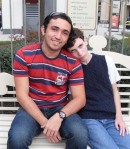 With the boom in on-line video, Cultural Care develops a unique application– aupairvideos.com – a website for videos of au pair candidates. Families appreciate the opportunity to take a closer look at the au pairs they are considering. This exclusive website provides candidates the chance to show their motivation and personality that goes beyond a paper application and telephone interview. This first-in-the-industry service has hundreds of au pair videos on-line for host families to view. Families also have the ability to upload their own video to show to a prospective au pair. Touched by the personal relationship between their au pair and their special needs son, the Boyer family of Virginia nominate their au pair, Ricardo Silva de Araújo of Brazil, as International Au Pair of the Year and once again a Cultural Care au pair is selected as the winner of this prestigous honor.
With the boom in on-line video, Cultural Care develops a unique application– aupairvideos.com – a website for videos of au pair candidates. Families appreciate the opportunity to take a closer look at the au pairs they are considering. This exclusive website provides candidates the chance to show their motivation and personality that goes beyond a paper application and telephone interview. This first-in-the-industry service has hundreds of au pair videos on-line for host families to view. Families also have the ability to upload their own video to show to a prospective au pair. Touched by the personal relationship between their au pair and their special needs son, the Boyer family of Virginia nominate their au pair, Ricardo Silva de Araújo of Brazil, as International Au Pair of the Year and once again a Cultural Care au pair is selected as the winner of this prestigous honor.




Leave a comment